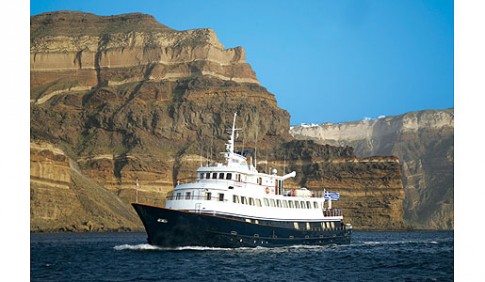
Q&A On Luxury Small Ship Cruising
Vasos Papagapitos
Vasos Papagapitos, President of Travel Dynamics, one of our esteemed travel partners specializing in small ship educational enrichment cruises, talks with Smithsonian Journeys staff member MaryBeth Mullen about the distinctive small ships, Corinthian II and Callisto.
Q. How is small ship cruising aboard the Corinthian II and Callisto different from other cruises?
A. Small ship cruising differs from traveling aboard large ships in many ways, some more obvious than others. One of the great advantages of small ship cruising is the access to smaller ports and harbors that are off limits to larger ships. Then there is the ease and convenience of disembarking only 100 or fewer guests for shore excursions, as compared to several hundred. Aboard our small ships, flexibility prevails, so if there is something special and unexpected that we wish to take advance of ashore, we can always return to the ship a bit late and know that the dining room and ship’s staff will be happy to accommodate our schedule. And one of the true delights of small ship cruising is the relaxed and convivial atmosphere aboard, which fosters easy conversation with fellow travelers and new friendships.
Q. With nearly 20 international cruises planned aboard the Corinthian II and the Callisto for 2012, what are some of the most popular destinations?
A. In spite of the political upheaval in certain pockets of the Mediterranean Sea over the past year, the Mediterranean remains our most popular and resilient destination. Nothing can compare to the beauty and significance of its sites—whether dating from Greco-Roman times, or other periods. Contributing to the popularity of our Mediterranean voyages is the fact that we visit them through a the perspective of a particular theme, including a voyage that follows the route of Homer’s Odyssey, or a voyage that explores the Secret Art Treasures of Italy, and a voyage that examines the expansion of the Venetian Empire, sailing from Venice to Cyprus.
Q. The Corinthian II is an all-suite 114 guest ship. Can you describe the accommodations and amenities for first-time cruisers.
A. The accommodations aboard Corinthian II are very spacious, with a sleeping area and a sitting area, as well as marble-appointed bathroom. A number of suites have balconies. There is ample storage space, and the wonderful cabin stewardesses anticipate every need. Travelers consider their suites a true home away from home.
Q. What is the dining experience like on these smaller ships?
A. Guests enjoy continental cuisine, with an emphasis on fresh ingredients from the local marketplaces. We have an “open seating” tradition on board so that guests can dine with different travelers each evening, which makes for stimulating conversation. If guests prefer a quiet table for two, or to dine with friends, a table can be reserved through the maître. Lunch is often served in the dining room and on deck, so that guests can select their preferred venue. In addition to breakfast in the dining room, coffee and pastries are served on deck for early risers.
Q. In addition to the Corinthian II, you also offer programs aboard a much smaller vessel, the private yacht Callisto traveling to West Africa, Turkey and the Greek Isles. What is like traveling aboard such an intimate ship?
A. Traveling aboard Callisto is a true joy. Guests feel that they are on their own private yacht, and the ever-accommodating service personnel welcome them like family on board. We take full advantage of the unique properties of Callisto by visiting regions in greater depth and calling at ports that are unknown to larger vessels.
Q. Will there be Smithsonian study leaders and tour managers to handle logistics aboard each cruise?
A. Each trip is staffed by outstanding study leaders that bring an important educational dimension to the travel experience. Not only are their lecturers stimulating, but they are always accessible for one-on-one conversation. And our tour staff is well known for its warmth, professionalism, and expertise.
Q. On average, how many ports are visited throughout a cruise? Essentially, how active are these trips?
A. We generally visit a different port each day, so that on a nine night cruise, we might visit a total of nine or ten different ports during the cruise. In many ports we spend a full day to allow for a rich sightseeing program, which is always included in the price of the trip. Knowing that travelers enjoy relaxed time at sea, there are generally several days where we spend a half a day in port and the balance of the day at sea. The trips are active; however, travelers can decide whether they wish to participate in all of the organized activities and sightseeing, or strike out on their own from time to time.
Q. Where are you traveling this year? Do you have a favorite destination?
A. This year I look forward to traveling on our program to West Africa aboard Callisto. It is such an unusual and intriguing itinerary, and I am especially interested in seeing the islands of the Bijagos Archipelago, located off of the coast of Guinea-Bissau, known for their remarkable wildlife and the traditions of the Bijagos peoples. If I had to name a favorite destination—which is not easy to do—it would be the Aegean Islands, my homeland.
Click here for cruises aboard Corinthian II and here for cruises aboard Callisto.


/https://tf-cmsv2-journeys-media.s3.amazonaws.com/journeys/catalog/cover_image/Mar_24_SJ_Cover.jpg)
 Be the First to Know
Be the First to Know